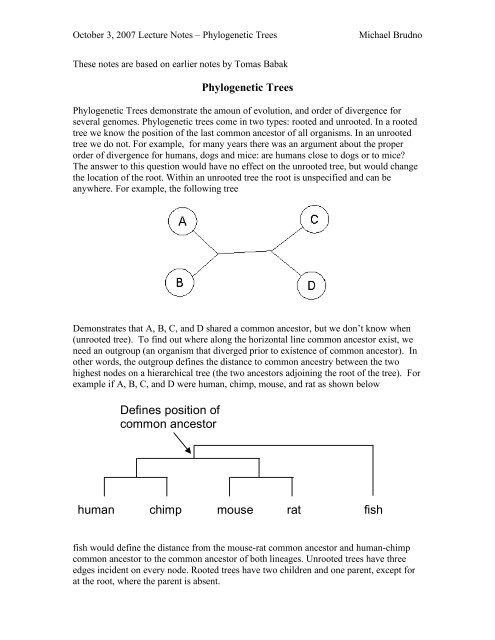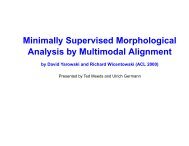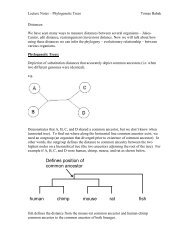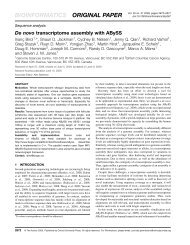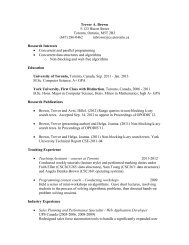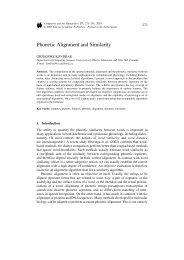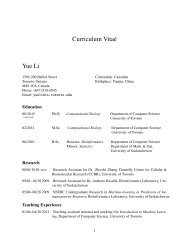human chimp mouse fish rat Defines position of common ancestor
human chimp mouse fish rat Defines position of common ancestor
human chimp mouse fish rat Defines position of common ancestor
You also want an ePaper? Increase the reach of your titles
YUMPU automatically turns print PDFs into web optimized ePapers that Google loves.
October 3, 2007 Lecture Notes – Phylogenetic Trees Michael Brudno<br />
These notes are based on earlier notes by Tomas Babak<br />
Phylogenetic Trees<br />
Phylogenetic Trees demonst<strong>rat</strong>e the amoun <strong>of</strong> evolution, and order <strong>of</strong> divergence for<br />
several genomes. Phylogenetic trees come in two types: rooted and unrooted. In a rooted<br />
tree we know the <strong>position</strong> <strong>of</strong> the last <strong>common</strong> <strong>ancestor</strong> <strong>of</strong> all organisms. In an unrooted<br />
tree we do not. For example, for many years there was an argument about the proper<br />
order <strong>of</strong> divergence for <strong>human</strong>s, dogs and mice: are <strong>human</strong>s close to dogs or to mice?<br />
The answer to this question would have no effect on the unrooted tree, but would change<br />
the location <strong>of</strong> the root. Within an unrooted tree the root is unspecified and can be<br />
anywhere. For example, the following tree<br />
Demonst<strong>rat</strong>es that A, B, C, and D shared a <strong>common</strong> <strong>ancestor</strong>, but we don’t know when<br />
(unrooted tree). To find out where along the horizontal line <strong>common</strong> <strong>ancestor</strong> exist, we<br />
need an outgroup (an organism that diverged prior to existence <strong>of</strong> <strong>common</strong> <strong>ancestor</strong>). In<br />
other words, the outgroup defines the distance to <strong>common</strong> ancestry between the two<br />
highest nodes on a hierarchical tree (the two <strong>ancestor</strong>s adjoining the root <strong>of</strong> the tree). For<br />
example if A, B, C, and D were <strong>human</strong>, <strong>chimp</strong>, <strong>mouse</strong>, and <strong>rat</strong> as shown below<br />
<strong>Defines</strong> <strong>position</strong> <strong>of</strong><br />
<strong>common</strong> <strong>ancestor</strong><br />
<strong>human</strong> <strong>chimp</strong> <strong>mouse</strong> <strong>rat</strong><br />
<strong>fish</strong><br />
<strong>fish</strong> would define the distance from the <strong>mouse</strong>-<strong>rat</strong> <strong>common</strong> <strong>ancestor</strong> and <strong>human</strong>-<strong>chimp</strong><br />
<strong>common</strong> <strong>ancestor</strong> to the <strong>common</strong> <strong>ancestor</strong> <strong>of</strong> both lineages. Unrooted trees have three<br />
edges incident on every node. Rooted trees have two children and one parent, except for<br />
at the root, where the parent is absent.
October 3, 2007 Lecture Notes – Phylogenetic Trees Michael Brudno<br />
Building Trees<br />
There are two types <strong>of</strong> approaches to building trees: (i) Distance based methods, which<br />
work from pairwise distances between the sequences (e.g. UPGMA, Neighbour Joining),<br />
(ii) character-based methods, which work directly from multiply aligned sequences (e.g.<br />
parsimony and likelihood approaches). While character-based methods are more<br />
accu<strong>rat</strong>e, they are also more complicated, and beyond the scope <strong>of</strong> the class. However it<br />
is notable that most phylogeny inference packages (e.g. PAML) use these.<br />
Distance-based approaches are also important because they represent a type <strong>of</strong> algorithm<br />
that w will see many times throughout this class – clustering. In particular the UPGMA<br />
approach we will discuss next is a classical example <strong>of</strong> hierarchical clustering.<br />
UPGMA<br />
A straightforward method to draw a tree is a greedy approach called the Unweighted Pair<br />
Group Method using Arithmetic Averages (UPGMA). A tree is drawn by recursively<br />
joining two closest nodes, grouping them into one cluster, and treating them as single<br />
node to which new distances are calculated. This is done until only two nodes remain.<br />
Suppose you are given four sequences sepa<strong>rat</strong>ed by the following distances:<br />
A<br />
B 4<br />
A B C D<br />
C 5 8<br />
D 7 9 7<br />
To construct the tree we begin with a star tree, where the initial branch point is arbitrary.<br />
A<br />
B<br />
C<br />
D
October 3, 2007 Lecture Notes – Phylogenetic Trees Michael Brudno<br />
A and B are the closest so let’s group them under a new node called F and calculate the<br />
distances to the new node:<br />
The distance from C to F can be calculated as:<br />
d(<br />
C,<br />
B)<br />
+ d(<br />
C,<br />
A)<br />
! d(<br />
A,<br />
B)<br />
d(<br />
C,<br />
F)<br />
=<br />
2<br />
You divide by 2 because you covered the path from C to F twice. The distance matrix<br />
then becomes:<br />
F<br />
C 4.5<br />
F C D<br />
D 6 7<br />
F and C are now closest, repeating the procedure by grouping C and F into G produces<br />
the following tree:<br />
N.B. This is still an unrooted tree as we do not know when C and D diverged.<br />
Neighbor Joining<br />
A<br />
B<br />
A<br />
B<br />
F<br />
F G<br />
C<br />
UPGMA produces the correct tree when the mutation <strong>rat</strong>es along all branches are equal,<br />
however, this is not always the case. Consider the following phylogenetic tree (known to<br />
be correct):<br />
D<br />
C<br />
D
October 3, 2007 Lecture Notes – Phylogenetic Trees Michael Brudno<br />
(http://www.icp.ucl.ac.be/~opperd/private/neighbor.html)<br />
In this case B diverged more quickly than A. Thus, UPGMA would join A and C<br />
producing an incorrect tree topology. Neighbour Joining (NJ) was developed to take<br />
non-uniform divergence <strong>rat</strong>es into account. The idea is to produce a modified distance<br />
matrix that takes into account the net divergence <strong>rat</strong>e <strong>of</strong> the entire tree, so that nodes<br />
close together but far apart from all other nodes are not necessarily joined directly.<br />
Saitou and Nei (1987) derived a model for calculating the modified matrix. If d is the<br />
original distance matrix, the modified matrix<br />
D ij = dij<br />
! ( Ri<br />
+ R j )<br />
where,<br />
1<br />
R i = dim.<br />
N # 2<br />
!<br />
m"<br />
N<br />
N is the set <strong>of</strong> leaves in the tree. The number <strong>of</strong> leaves is | N |. The tree topology is<br />
constructed as described above (UPGMA) using the modified distance matrix D. Atteson<br />
(1999) proved this model to be correct under the assumption that the we are dealing with<br />
an additive tree (i.e. for any two leaves the distance between them is the sum <strong>of</strong> edges<br />
along a path that connects them).<br />
Suppose you have the following distance matrix d (corresponding to the above tree):<br />
,
October 3, 2007 Lecture Notes – Phylogenetic Trees Michael Brudno<br />
Ri, the net divergence matrix for each sequence is calculated as the sum <strong>of</strong> each node to<br />
all other nodes.<br />
R(A) = (5+4+7+6+8)/4 = 30/4,<br />
R(B) = 42/4,<br />
R(C) = 32/4,<br />
R(D) = 38/4,<br />
R(E) = 34/4,<br />
R(F) = 44/4.<br />
D is:<br />
It is now apparent that D and E, and A and B are closest and these are initially joined as<br />
neighbours.<br />
Sample calculation for Dij:<br />
D<br />
D<br />
D<br />
D<br />
ij<br />
AB<br />
AB<br />
AB<br />
= d<br />
ij<br />
= d<br />
! ( R + R<br />
AB<br />
! ( R<br />
A<br />
30 42<br />
= 5 ! ( + )<br />
4 4<br />
= ! 13<br />
i<br />
j<br />
)<br />
+ R<br />
B<br />
)<br />
We can now use the greedy algorithm to construct the tree. We would start by joining A<br />
and B (AB->S), since this is one <strong>of</strong> the minima <strong>of</strong> D (we could have also joined D and E,<br />
the other minimum), and recompute the distances to S (nodes joining AB; see figure<br />
below).
October 3, 2007 Lecture Notes – Phylogenetic Trees Michael Brudno<br />
B<br />
A<br />
C<br />
Subbing in S for A and B, we can calculate the distances from the remaining nodes to S,<br />
d(CS) = d(AC) + d(BC) - d(AB) / 2 = 3<br />
d(DS) = d(AD) + d(BD) - d(AB) / 2 = 6<br />
d(ES) = d(AE) + d(BE) - d(AB) / 2 = 5<br />
d(FS) = d(AF) + d(BF) - d(AB) / 2 = 7<br />
d becomes:<br />
S C D E F<br />
S<br />
C 3<br />
D 6 7<br />
E 5 6 5<br />
F 7 8 9 8<br />
Where D is:<br />
S C D E F<br />
S<br />
C -19.5<br />
D -18 -18.5<br />
E -17.5 -18 -20.5<br />
F -19.5 -20 -19 -20<br />
We would next join D and E -> T.<br />
F<br />
D<br />
E<br />
B<br />
A<br />
C<br />
S<br />
F<br />
D<br />
E
October 3, 2007 Lecture Notes – Phylogenetic Trees Michael Brudno<br />
B<br />
A<br />
C<br />
S<br />
F<br />
D<br />
E<br />
We would continue to join nodes, recalculate d and D until only two nodes remain.<br />
B<br />
A<br />
C<br />
S<br />
F<br />
T<br />
D<br />
E


